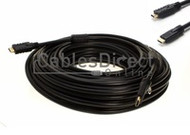HDMI
Posted by Yoel on Feb 15th 2014
What is HDMI?
HDMI (High-Definition Multimedia Interface) is the universal digital multimedia interface for transmitting of high-quality audio- and video contentas well as of control signals. In short, HDMI is the cable and connectors to it, through which you can simultaneously send the sound, video and commands of the distance operation console. The cable is able to transmit the video in HDTV format and higher (up to 2560x1440, color depth is 48 byte - billiard (!) of colors) and the eight-channel audio for 24 byte and with the frequency of up to 192kHz. HDMI is actively installed into domestic cinemas, video cards, monitors and TV sets. So, get rid of cables - you need just one of them!
What devices have HDMI?
As we've already said, very different multimedia devices can be equipped by HDMI: video, audio-receivers, DVD devices, HDTV sets, computers and game consoles. More than 400 manufacturers support HDMI. To switch a DVI-device to HDMI you'll need the adapter. By the way, DVI can also transmit HD video of the maximal quality (1080p60 - 1920x1080 pixels with 60 full cadres per second), the channel's speed is 5Hbit/sec.
How is HDMI made?
The HDMI cable consists of three enclosed pairs of wires (channels), through which video-, audio- and control signals are transmitted. Each HDMI channel in 1.3 version has the maximal carrying capacity in both ways of 10,2Hbyte/sec (carrier frequency 340Mhz against 140Mhz in HDMI 1.0). Separate wires of the cable are used for transmitting of the service signals for recognition of connected devices. The more compact mini-HDMI slot is developed for the 1.3 version.
What options are used for transmitting of video through HDMI?
HDMI of the version 1.3. provides the picture's resolution of 2560x1440 pixels with one billion (48 byte) color shadows and progressive (full-cadre, not interlaced) scanning. Besides HDTV, all basic TV formats are supported including PAL, NTSC, ATSC etc. Synchronization of video and audio upon markers (lip movements of actors) is provided.
What options are used for transmitting of audio through HDMI?
HDMI 1.3 allows transmitting of the 8-channel 24-byte sound with the frequency of up to 192kHz. Recently, 44Hz have been considered to be adequate for the high-quality digital sound. The most progressive sound compression technologies are supported, such as Dolby Digital 5.1, Dolby TrueHD and DTS-HD.
What for the control channel is needed?
Several devices connected with each other can be operated from the same remote control, signals are transmitted through the control channel. You can switch on/off all remote devices by the one button.
The cable of what length can be used?
HDMI's specifications don't define the maximum possible length of the cable, it depends on the materials used and on the quality of production. The length of the copper cable can reach 15 meters, the distance becomes longer if the optic fibre is used. There are adapters for wireless transmission of HDMI signals but they still cost a lot of money.
What is HDCP?
HDCP (High-bandwith Digital Content Protection) is the technology of protection from copying of audio and video data transmitted through HDMI. During transmission, signals are cyphered by the transmitting party and decoded by the receiver device. Recording devices, such as DVD recorders, don't allow decoding and recording such signal.
Can DVI devices show the signal from HDCP?
Yes, they can, because the HDCP technology can be realized in the DVI interface too - for example, in a video card or a monitor.


